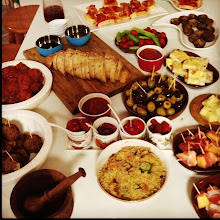Ingredients
- 1.5kg Mixed dried fruit (Sultanas,Raisins,Currants, Glace Cherries, Apricots) whatever you like)
- 150 - 200ml brandy
- 1 1/2 cups plain flour
- 1/2 cup self-raising flour
- 2 teaspoons mixed spice
- 1 teaspoon ground ginger
- 250g butter, softened
- 1 cup dark brown sugar
- 4 eggs, at room temperature
- 2 tablespoons orange marmalade
Method
- Place dried fruit, glace fruit and brandy (minus 2tablespoons for after cooking, optional)in a large airtight container. Mix well. Cover and stand overnight or preferably for 1 week, stirring occasionally.
- Lightly grease a large cake pan. Line base and sides with bake paper. Preheat oven to 150°C. Sift flours and spices into a bowl.
- Using
electric beaters, cream butter and sugar in a large bowl until pale
and creamy. Add eggs, 1 at a time, beating well after each addition.
Add marmalade and 1 tablespoon flour mixture and beat until well
combined. Using a large spoon, fold remaining flour mixture
into butter mixture.
- Add fruit mixture to butter mixture and stir until combined.
Press into pan. Smooth surface. Tap base of pan on workbench to
settle fruit and remove air bubbles.
(at this stage my family add a (very clean) coin to the mix for luck and Christmas tradition, whoever gets the coin on Christmas day gets the Christmas wish)
- Cover cake with 2 layers bake paper (cut circle to match the top). Bake for 3hours or until a skewer inserted into the centre comes out clean.
Drizzle remaining 2 tablespoons brandy over cake while still hot. (I omit this step as I serve mine to the little ones)
Wrap cake pan in a clean tea towel and allow to cool completely overnight is best.
Remove cake from pan and dust with icing sugar to serve immediately. Or wrap the cake well and store in a cool dry place for up to 4 weeks, 2 days before serving cover with marzipan and fondant icing and decorate!
 |
| Soak in Brandy for up to a week |

 |
| Cake before icing |
 |
| Use a roll out fondant for maximum effect |
 |
| Lay over the top press the sides and cut off the excess with a knife |
 |
| Decorate |

























